steering wheel BUICK CENTURY 1994 Owners Manual
[x] Cancel search | Manufacturer: BUICK, Model Year: 1994, Model line: CENTURY, Model: BUICK CENTURY 1994Pages: 308, PDF Size: 16.3 MB
Page 41 of 308
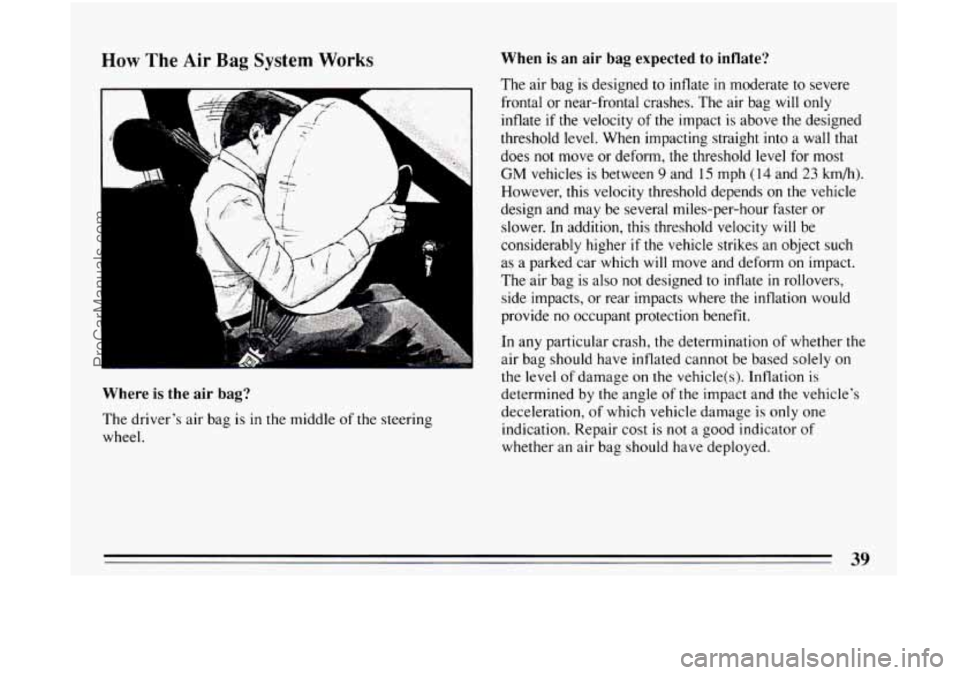
How The Air Bag System Works When is an air bag expected to inflate?
Where is the air bag?
The driver’s air bag is in the middle of the steering
wheel. The air
bag is designed to inflate
in moderate to severe
frontal or near-frontal crashes. The air bag
will only
inflate
if the velocity of the impact is above the designed
threshold level. When impacting straight into a wall that
does
not move or deform, the threshold level for most
GM vehicles is between 9 and 15 mph (1 4 and 23 km/h).
However, this velocity threshold depends
on the vehicle
design and may be several miles-per-hour faster or
slower. In addition, this threshold velocity will be
considerably higher
if the vehicle strikes an object such
as a parked car which will move and deform on impact.
The air bag is also
not designed to inflate in rollovers,
side impacts, or rear impacts where the inflation would
provide no occupant protection benefit.
In any particular crash, the determination of whether
the
air bag should have inflated cannot be based solely on
the level of damage on the vehicle(s). Inflation is
determined by the angle of the impact and the vehicle’s
deceleration, of which vehicle damage
is only one
indication. Repair cost
is not a good indicator of
whether an air bag should have deployed.
39
ProCarManuals.com
Page 42 of 308

What makes an air bag inflate?
In a frontal impact of sufficient severity, the air bag
sensing system detects that the vehicle is suddenly
stopping as a result of a crash. The sensing system
triggers a chemical reaction
of the sodium azide sealed
in the inflator. The reaction produces nitrogen gas,
which inflates the cloth bag. The inflator, cloth bag, and
related hardware are all part
of the air bag inflator
module packed inside the steering wheel.
How does an air bag restrain?
In moderate to severe frontal or near-frontal collisions,
even belted occupants can contact the steering wheel.
The air bag supplements
the protection provided by
safety belts. Air bags distribute the force of the impact
more evenly over the occupant’s upper body, stopping
the occupant more gradually. But air bags would not
provide protection in many types
of collisions, including
rollovers and rear and side impacts, primarily because
an occupant’s motion is not toward the air bag. Air bags
should never be regarded as anything more than a
supplement to safety belt protection in moderate
to
severe frontal and near-frontal collisions.
What will you see after an air bag inflation?
After the air bag has inflated, it will then quickly
deflate. This occurs
so quickly that some people may
not even realize that the air bag inflated. Some
components of the air bag module in the steering wheel
hub may be hot for a short time, but the portion of the
bag that comes into contact with
you will not be hot to
the touch. There will be small amounts of smoke and
dust coming from vents in the deflated air bag. The air
bag will
not impede the driver’s vision or ability to steer
the vehi,cle, nor will it hinder the occupants from exiting
the vehicle.
The air bag is designed to inflate only once. After it
inflates, you’ll need some new parts for your air bag
system. If you don’t get them, the air bag system
won’t be there to help protect you in another crash.
A new system will include the air bag module and
possibly other parts. The service manual has
information about the need to replace other parts.
0 Your vehicle is equipped with a diagnostic module,
which records information about the air bag system.
The module records information about the readiness
of the system, when the sensors are activated and
whether the driver’s safety belt was
in use.
40
ProCarManuals.com
Page 43 of 308
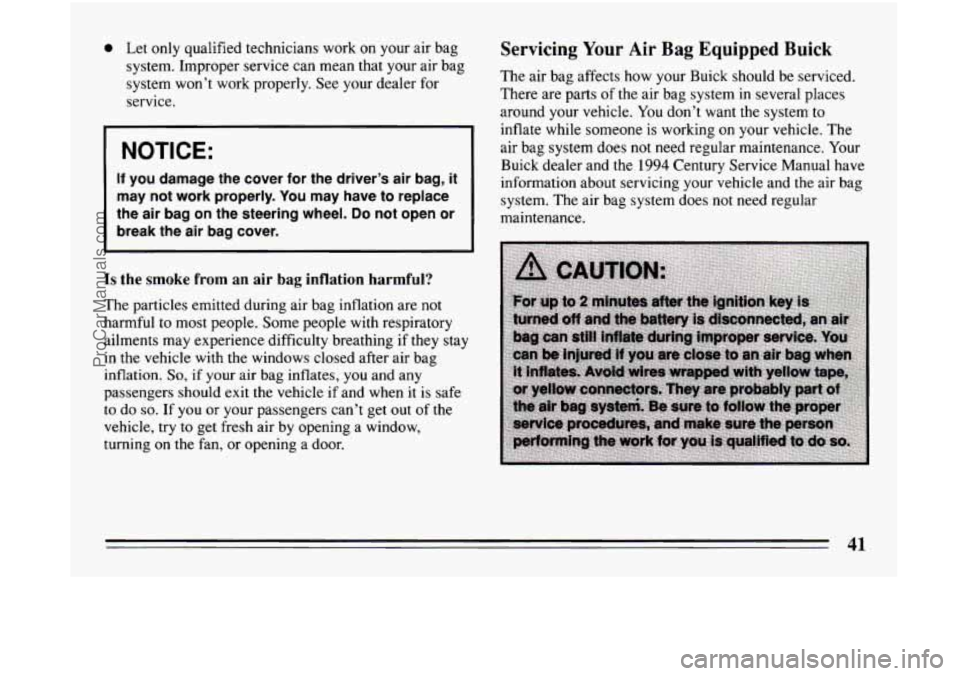
0 Let only qualified technicians work on your air bag
system. Improper service can mean that your air bag
system won’t work properly. See your dealer for
service.
NOTICE:
If you damage the cover for the driver’s air bag, it
may not work properly. You may have to replace
the air bag on the steering wheel.
Do not open or
break the air bag cover.
Is the smoke from an air bag inflation harmful?
The particles emitted during air bag inflation are not
harmful to most people. Some people with respiratory
ailments may experience difficulty breathing if they stay
in the vehicle with the windows closed after air bag
inflation.
So, if your air bag inflates, you and any
passengers should exit the vehicle if and when it is safe
to
do so. If you or your passengers can’t get out of the
vehicle, try
to get fresh air by opening a window,
turning on the fan, or opening a door.
Servicing Your Air Bag Equipped Buick
The air bag affects how your Buick should be serviced.
There are parts
of the air bag system in several places
around your vehicle. You don’t want the system to
inflate while someone is working on your vehicle. The
air bag system does not need regular maintenance. Your
Buick dealer and the
1994 Century Service Manual have
information about servicing your vehicle and the air bag
system. The air bag system does not need regular
maintenance.
41
ProCarManuals.com
Page 67 of 308
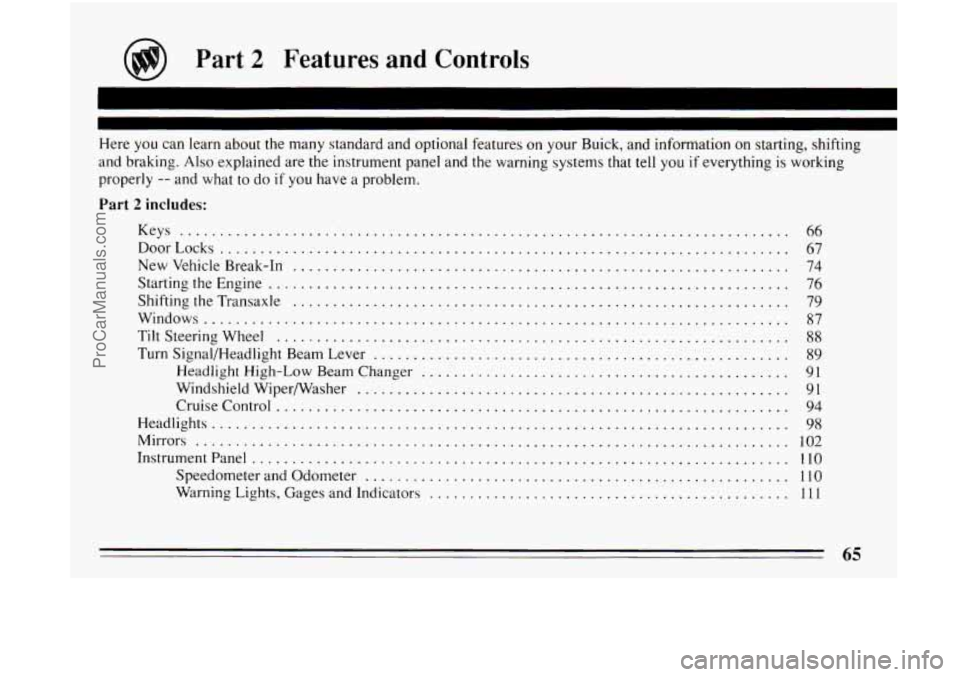
?art 2 Features and Controls
Here you can learn about the many standard and optional features on your Buick. and information on starting. shifting
and braking
. Also explained are the instrument panel and the warning systems that tell you if everything is working
properly
.. and what to do if you have a problem .
Part 2 includes:
Keys ........................................................................\
.. 66
DoorLocks .............................. ................................... 67
New Vehicle Break-In ..................... ..................................... 74
StartingtheEngine
................................................................. 76
ShiftingtheTransaxle ............................................................ 79
Windows ....................................................................... \
87
TiltSteeringWheel
................................................................ 88
Turn Signal/Headlight Beam Lever .................................................... 89
Headlight High-Low Beam Changer
.............................................. 91
Windshield Wipermasher ...................................................... 91
CruiseControl
................................................................ 94
Headlights
........................................................................\
98
Mirrors ........................................................................\
.. 102
Instrumentpanel ................................................................... 110
Speedometer and Odometer ..................................................... 110
Warning Lights . Gages and Indicators ............................................. 111
65
ProCarManuals.com
Page 76 of 308

Theft
Vehicle theft is big business, especially in some cities. Although your Buick has a number of theft deterrent
features, we know that nothing we put on it can make
it
impossible to steal. However, there are ways you can help.
Key in the Ignition
If you walk away from your vehicle with the keys
inside, it’s an easy target for joy riders or professional
thieves
-- so don’t do it.
When you park your Buick and open the driver’s door,
you’ll hear a chime reminding you to remove your key
from the ignition and take it
with you. Always do this.
Your steering wheel
will be locked, and so will your
ignition and transaxle. And remember to lock the doors.
Parking at Night
Park in a lighted spot, close all windows and lock your
vehicle. Remember to keep your valuables out
of sight.
Put them
in a storage area, or take them with you.
Parking Lots
If you park in a lot where someone will be watching
your vehicle, it’s best to lock
it up and take your keys. But what
if
you have to leave your ignition key? What if
you have to leave something valuable in your vehicle?
0 Put your valuables in a storage area, like your trunk
or glove box, or rear storage area in the wagon.
0 Lock the glove box.
0 Lock all the doors except the driver’s.
0 Then take the door key with you.
New Vehicle “Break-In”
I NOTICE:
Your modern Buick doesn’t need an elaborate
“break-in.” But
it will perform better in the long
run if you follow these guidelines:
Don’t drive at any one speed -- fast or slow
-- for the first 500 miles (804 km). Don’t
make full-throttle starts.
0 Avoid making hard stops for the first 200
miles (322 km) or so. During this time your
new brake linings aren’t yet broken
in. Hard
stops with new linings can mean premature
wear and earlier replacement. Follow this
“breaking-in” guideline every time you get
new brake linings.
74
ProCarManuals.com
Page 77 of 308
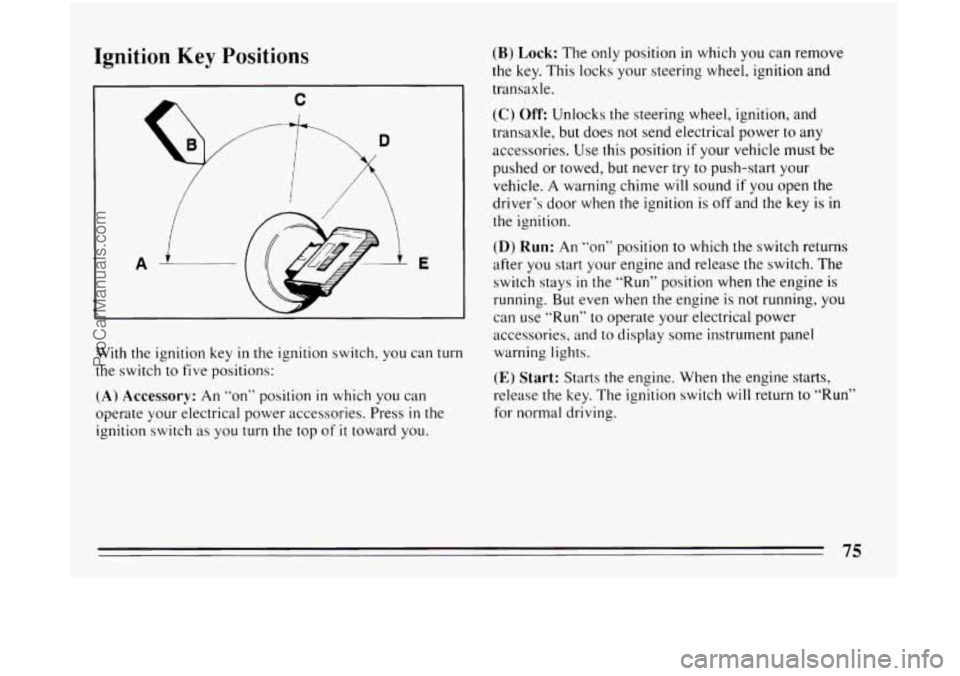
Ignition Key Positions
C
9.5 B
A i E
With the ignition key in the ignition switch, you can turn
the switch to five positions:
(A) Accessory: An “on” position in which you can
operate your electrical power accessories. Press
in the
ignition switch as you turn the top
of it toward you.
(B) Lock: The only position in which you can remove
the key. This locks
your steering wheel, ignition and
transaxle.
(C) Off: Unlocks the steering wheel, ignition, and
transaxle, but does not send electrical power
to any
accessories. Use this position
if your vehicle must be
pushed or towed, but never
try to push-start your
vehicle.
A warning chime will sound if you open the
driver’s door when the ignition is off and the
key is in
the ignition.
(D) Run: An ‘‘on’’ position to which the switch returns
after you start your engine and release
the switch. The
switch stays
in the “Run” position when the engine is
running. But even when the engine is
not running, you
can use
“Run” to operate your electrical power
accessories, and to display some instrument panel
warning lights.
(E) Start: Starts the engine. When the engine starts,
release the key. The ignition switch will return
to “Run”
for normal driving.
ProCarManuals.com
Page 78 of 308
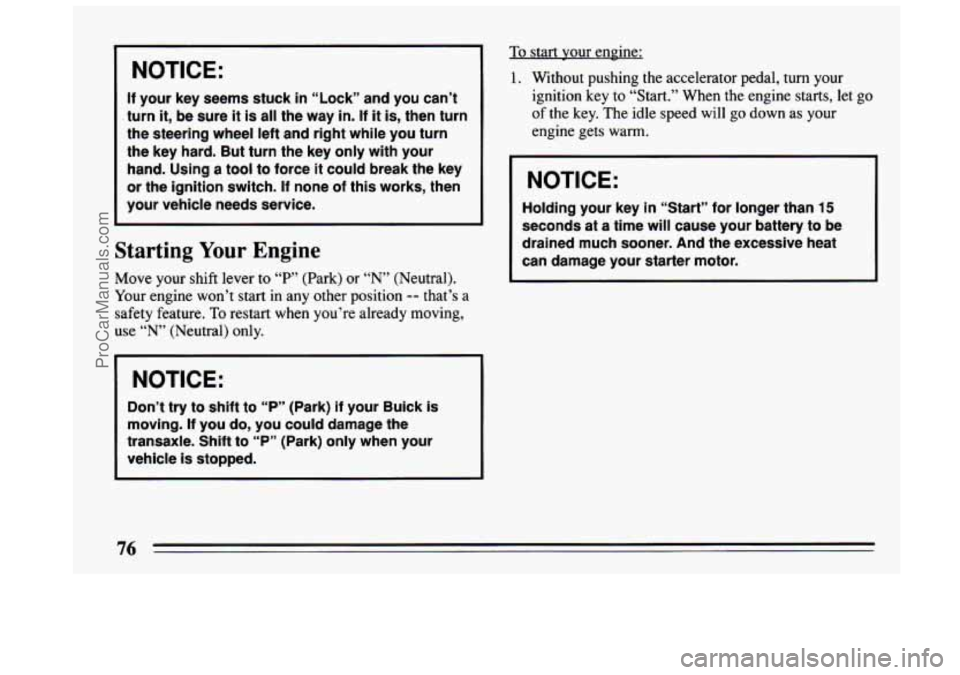
NOTICE:
If your key seems stuck in “Lock” and you can’t
. turn it, be sure it is all the way in. If it is, then turn
the steering wheel left and right while you turn
the key hard. But turn the key only with your
hand. Using a tool to force it could break the key
or the ignition switch. If none of this works, then
your vehicle needs service.
Starting Your Engine
Move your shift lever to “P” (Park) or “N” (Neutral).
Your engine won’t start in any other position
-- that’s a
safety feature. To restart when you’re already moving,
use
“N’ (Neutral) only.
NOTICE:
Don’t try to shift to “P” (Park) if your Buick is
moving.
If you do, you could damage the
transaxle. Shift to
“P” (Park) only when your
vehicle is stopped.
To start your engine:
1. Without pushing the accelerator pedal, turn your
ignition key to “Start.” When the engine starts,
let go
of the key. The idle speed will go down as your
engine gets warm.
NOTICE:
Holding your key in “Start” for longer than 15
seconds at a time will cause your battery to be
drained much sooner. And the excessive heat
can damage your starter motor.
76
ProCarManuals.com
Page 90 of 308
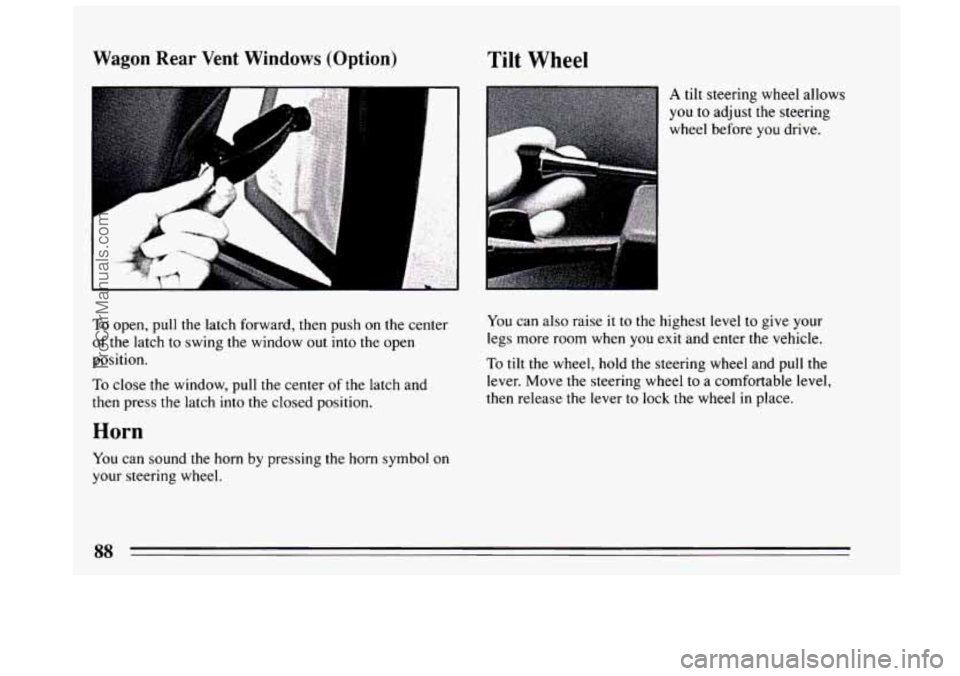
Wagon Rear Vent Windows (Option)
To open, pull the latch forward, then push on the center
of the latch to swing the window out into the open
position.
To close the window, pull the center of the latch and
then press the latch into the closed position.
Horn
You can sound the horn by pressing the horn symbol on
your steering wheel.
Tilt Wheel
A tilt steering wheel allows
you to adjust the steering
wheel before
you drive.
You can also raise it to the highest level to give y6ur
legs more room when you exit and enter the vehicle.
To tilt the wheel, hold the steering wheel and pull the
lever. Move the steering wheel
to a comfortable level,
then release the lever to lock the wheel in place.
88
ProCarManuals.com
Page 149 of 308

Remember: Anti-lock doesn’t change the time you need
to get your foot up to the brake pedal. If you get too
close
to the vehicle in front of you, you won’t have time
to apply your brakes
if that vehicle suddenly slows or
stops. Always leave enough room up ahead to stop, even
though you have anti-lock brakes.
Steering
Power Steering
If you lose power steering assist because the engine
stops or the system is not functioning, you can steer but
it will take much more effort.
To Use Anti-Lock
Don’t pump the brakes. Just hold the brake pedal down
and let anti-lock
work for you. You may feel the system
working, or
you may notice some noise, but this is
normal. When your anti-lock system is adjusting brake
pressure to help avoid a braking skid, the
“LOW
TRACTION” light will come on. See “Anti-Lock Brake
System Active Light”
in the Index.
Braking in Emergencies
Use your anti-lock braking system when you need to.
With anti-lock, you can steer and brake at the same
time. In many emergencies, steering can help
you more
than even
the very best braking.
Steering Tips
Driving on Curves
It’s important to take curves at a reasonable speed.
A lot of the “driver lost control” accidents mentioned on
the news happen on curves. Here’s why:
Experienced driver or beginner, each of us is subject to
the same laws
of physics when driving on curves. The
traction of the tires against the road surface makes
it
possible for the vehicle to change its path when you turn
the front wheels. If there’s no traction, inertia will keep
the vehicle going
in the same direction. If you’ve ever
tried to steer
a vehicle on wet ice, you’ll understand this.
The traction
you can get in a curve depends on the
condition of your tires and the road surface, the angle at
which
the curve is banked, and your speed. While
you’re
in a curve, speed is the one factor you can
control.
147
ProCarManuals.com
Page 150 of 308
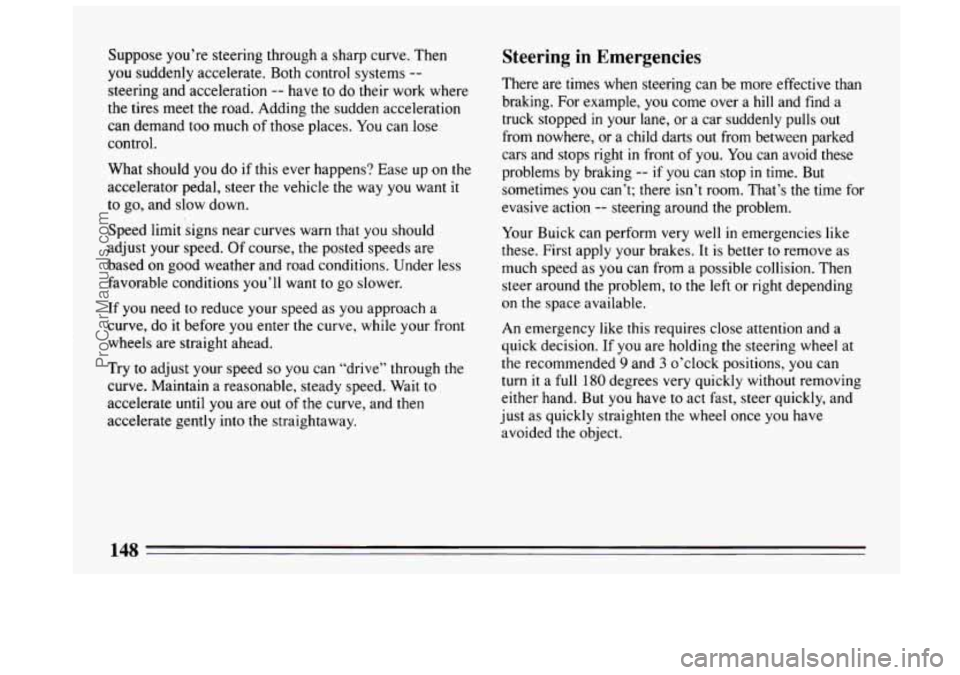
Suppose you’re steering through a sharp curve. Then
you suddenly accelerate. Both control systems --
steering and acceleration -- have to do their work where
the tires meet the road. Adding the sudden acceleration
can demand too much of those places. You can lose
control.
What should you do
if this ever happens? Ease up on the
accelerator pedal, steer the vehicle the way you want
it
to go, and slow down.
Speed limit signs near curves warn that you should
adjust your speed. Of course, the posted speeds are
based on good weather and road conditions. Under less
favorable conditions
you’ll want to go slower.
If you need to reduce your speed as you approach a
curve, do
it before you enter the curve, while your front
wheels are straight ahead.
Try to adjust your speed
so you can “drive” through the
curve. Maintain a reasonable, steady speed. Wait to
accelerate until you are
out of the curve, and then
accelerate gently into the straightaway.
Steering in Emergencies
There are times when steering can be more effective than
braking.
For example, you come over a hill and find a
truck stopped in your lane, or a car suddenly pulls out
from nowhere, or a child darts out from between parked
cars and stops right
in front of you. You can avoid these
problems by braking
-- if you can stop in time. But
sometimes you can’t; there isn’t room. That’s
the time for
evasive action
-- steering around the problem.
Your Buick can perform very well
in emergencies like
these. First apply your brakes. It is better to remove as
much speed as you can from a possible collision. Then
steer around the problem, to the left or right depending
on the space available.
An emergency like this requires close attention and a
quick decision. If you are holding the steering wheel at
the recommended 9 and 3 o’clock positions, you can
turn
it a full 180 degrees very quickly without removing
either hand. But you have
to act fast, steer quickly, and
just as quickly straighten the wheel once you have
avoided the object.
148
ProCarManuals.com